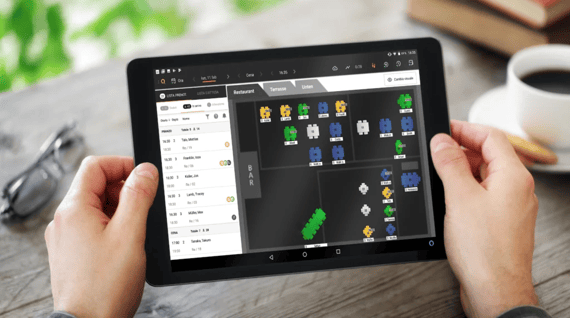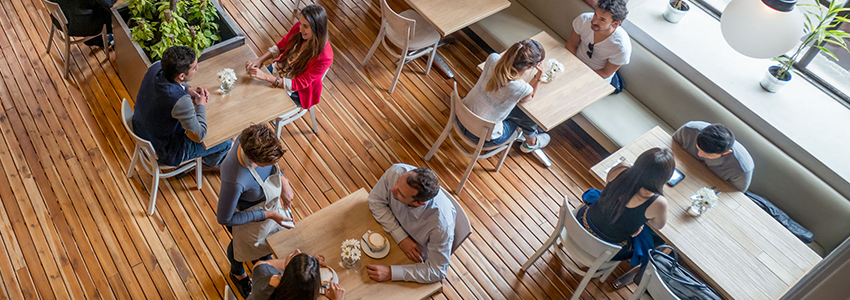How To Design an Efficient Restaurant Floor Plan
Restaurant space is precious, so invest time and thought into your floor plan design. A well-designed plan will benefit your restaurant in two ways: You’ll improve your restaurant operations and elevate the dining experience.
A restaurant floor plan can include everything from structural elements to furnishing. In this article, we’ll focus on the table plan of your dining areas and give you actionable tips on how to design your own. Read on to learn how to maximise table capacity, serve diners efficiently and increase diner spending.
Why you need an efficient restaurant layout
The best restaurant table plans make your waiting staff’s job easy. It also creates a welcoming space that diners will want to revisit.
Your waiting staff will need enough space to move around quickly and unhindered. Pay special attention to service areas that are at risk for congestion – this includes your checkout and entrance areas, and food stations where they pick up orders.

A well-designed restaurant layout also leaves diners impressed. Think of your table plan as the foundation of your restaurant’s interior: It brings furniture, lighting and decorations together. Cluttered table plans can overshadow the rest of the dining experience – and even affect diner spending.
Research shows that diners find crowded tables uncomfortable, and spend more when seated at tables with plenty of space. Certain tables are often considered less desirable by diners. This includes tables right by the entrance or next to the bathrooms. By identifying these areas in the planning stage, you can modify your table plan to improve the perceived quality of these tables.
Finally, your layout should adhere to local building regulations. Be conscious of safety regulations and to leave enough space between tables for wheelchair access. Small restaurants may be exempt from certain accessibility requirements (depending on location). If this is the case for your restaurant, you can plan in wheelchair friendly tables close to the entrance area – to make your restaurant as inclusive as possible.
3 tips for designing your restaurant table plan
Choosing your restaurant table plan is a big decision, so set aside time for proper planning. You might even hire an interior design firm – either way, consider the following factors before you start:
- Do you know who your target customer is? Your restaurant’s style and table plan will help you attract a certain type of diner – so let your restaurant’s interior reflect your brand, price-range and cuisine. Spatial requirements also come into play: A full-service fine dining restaurant typically requires more space between tables than a casual lunch spot.
- Would you like to have an open floor plan, or does your venue have multiple rooms? Each has its pros and cons. Open floor plans look impressive and they’re easy for your waiting staff to navigate. Separated rooms can make it challenging for staff to pay attention to diners – but tend to create a more intimate atmosphere.
- Which type of furniture is best suited for your needs? You might choose a mix of tables for groups of different sizes. Or you can opt for smaller, uniform tables – and group them as needed for large parties.
The key is to strike a balance between consistency and flexibility. Aim to design your table plan to meet your daily needs, but leave room for flexibility. That way you can quickly change your layout for special events. Combine this with your budget and venue limitations – and you’re off to a great start.
Optimise your table plan with table management software
Optimising seating capacity is one of the most important reasons for designing your table plan. There is no one-size-fits-all formula, but luckily you can use table management systems to ease the job. Quandoo for Restaurants is one such solution – try our tools to maximise your restaurant's capacity.
You can access your reservation data and cover performance, which makes it easier to optimise your table plan. Do you know what your average party size is during peak hours? Use these findings to accommodate the right diners and optimise your table layout accordingly.

You’ll also benefit from simplified operations. We help you set up your restaurant’s seating areas in our system so they match your restaurant's layout – indoor and outdoor. Our interactive table plan lets you drag and drop reservations and walk-ins as needed. For full flexibility, you can even block tables, create table combinations and assign them on the go.
This way you can manage reservations and turn tables faster, all in one tool. Check out our full list of features here.
Tips for small restaurant layouts
Owners of small restaurants know better than anyone that table plan optimisation matters. Try maximising your restaurant’s seating capacity with these added tips:
- Experiment with different options to create the most efficient table plan. Try sketching solutions and try them out in real life.
- Make the most of every square foot. Consider bar seating and if you can fit smaller tables in window nooks or corners.
- Choose smaller, lightweight furniture for a light and spacious look.
- Get creative with room dividers and decorations to improve less desirable areas – use furniture to create natural walkways for your waiting staff.
Don’t let the challenge of a small restaurant space demotivate you. Limited space requires out-of-the-box thinking that often results in the most creative solutions of all.
Set yourself up for success with the right restaurant table plan
A well-designed restaurant table plan lets you seat more diners and improves working conditions for your staff. Creating a welcoming space also encourages diners to return and spend more.
Follow these practices and you’re off to a head start. To optimise your layout even further, get started with Quandoo for Restaurants. Our sales team is here for you – get in touch.



